It is often the small states that lead. While New York and California have gotten the big press for their ambitious clean energy mandates, the first really aggressive renewable portfolio standard (RPS) policies were passed in the summer of 2015 in Vermont (75% by 2032) and Hawaii (100% by 2045).
And now Maine is taking its turn. Yesterday afternoon Maine Governor Janet Mills (D) signed three bills to revive the transition to renewable energy in the state, including LD 1494, which requires that the state’s utilities get 50% of their power from qualified renewable energy sources by 2030.
And while this 50% by 2030 is tied with a number of other states for only the fifth-strongest requirement on paper, due to the estimated 30% of its power that Maine gets from renewable energy resources that don’t fit into its mandate (likely large hydro dams), the state will have one of the lowest-carbon electricity fleets in the nation by 2030, with only Washington DC and Washington State expected to exceed this.
Along with this Mills has signed LD 1171, which will create a block grant program to support the installation of 375 MW of distributed solar by mid-2024. Finally, Mills has signed another bill to create a statewide climate council tasked with leading the state to a 45% reduction in greenhouse gas emissions by 2030, based on 1990 levels.
Growing solar
Maine has an unusual electricity profile, with hydroelectric power and biomass – largely woody biomass from the state’s timber industry – as the two largest sources of the 40% of its power that it gets from renewables.
The state also has a large amount of wind generation, but it is not clear how much of this is claimed by other states. The more densely populated states of Massachusetts, Connecticut and Rhode Island often meet renewable energy targets by procuring electricity from wind and other projects outside of their borders, due to a variety of factors including the rampant NIMBYism of affluent populations.
In terms of solar Maine is far behind, with in-state solar meeting only 0.6% of the state’s electricity demand in 2018. Maine’s solar market has a lot of recovery to do, battered as it was by former Governor Paul LePage’s (R) “gross metering” policy.
The new block grant program created under LD 1171 could be a good start to that rebuilding process, as block grant programs have been successfully used in California and New York to kick-start distributed solar markets. Under the program, Maine regulators are tasked with setting up an initial procurement of 25 MW of distributed generation and 50 MW of community solar projects, with bids to be submitted no later than the summer of 2020.
From the prices obtained in this auction the state will set up declining block grant programs for the remaining 100 MW of distributed generation and 200 MW of community solar, which is termed “large-scale shared distributed generation resources.”
This 375 MW of new solar would increase the state’s capacity nearly seven-fold over the 55 MW it had installed at the end of 2018. And while Maine may add even more than that given that net metering has also been revived, based on 2017 capacity factors for solar in the state this volume alone should meet between 3.5 and 4% of the state’s electricity demand.
This content is protected by copyright and may not be reused. If you want to cooperate with us and would like to reuse some of our content, please contact: editors@pv-magazine.com.









By submitting this form you agree to pv magazine using your data for the purposes of publishing your comment.
Your personal data will only be disclosed or otherwise transmitted to third parties for the purposes of spam filtering or if this is necessary for technical maintenance of the website. Any other transfer to third parties will not take place unless this is justified on the basis of applicable data protection regulations or if pv magazine is legally obliged to do so.
You may revoke this consent at any time with effect for the future, in which case your personal data will be deleted immediately. Otherwise, your data will be deleted if pv magazine has processed your request or the purpose of data storage is fulfilled.
Further information on data privacy can be found in our Data Protection Policy.